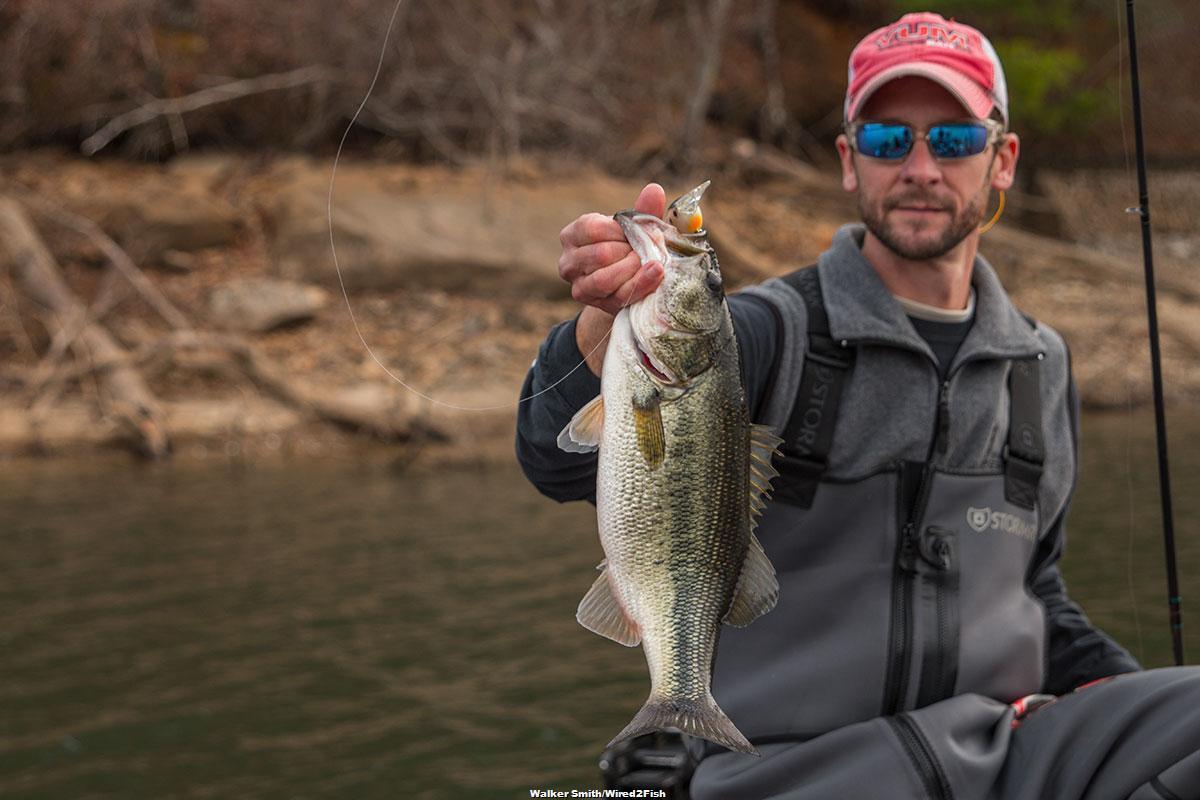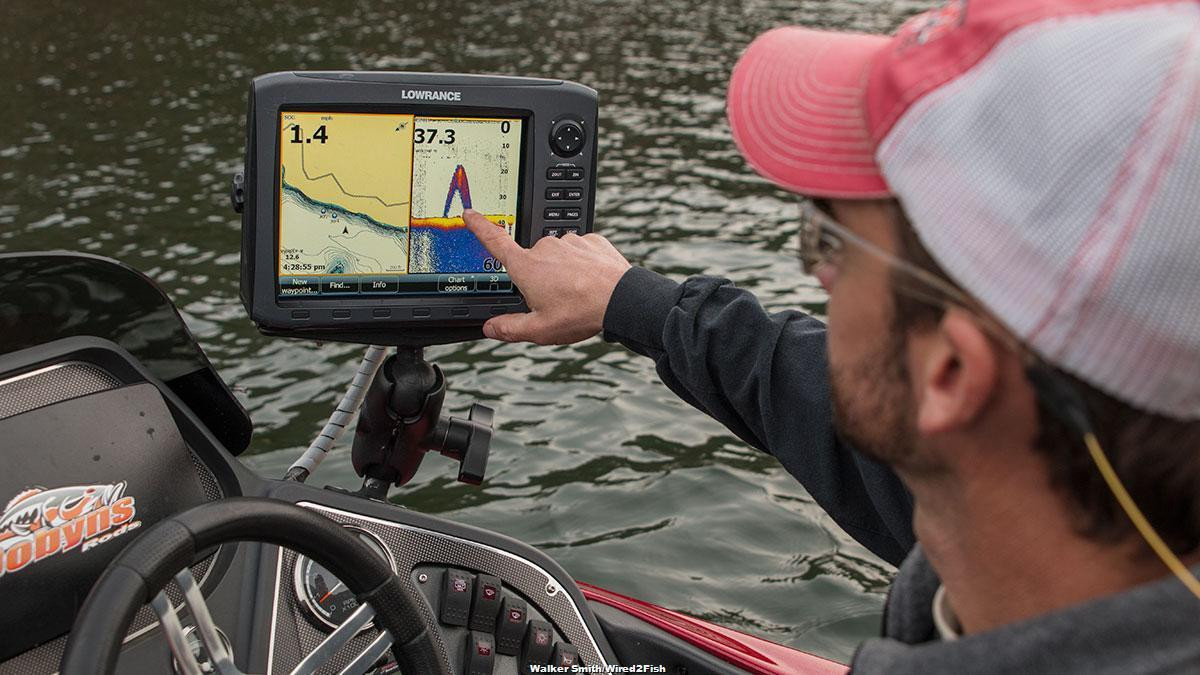Let’s be candid with each other for a minute. It can be difficult, even impossible, at times, to get motivated for winter bass fishing. The fish are excruciatingly lethargic, our line guides turn to ice with each cast and our fingers and hands are often paralyzed with a prickling pain.
But guess what? We’re bass fisherman. No matter how much the weather stinks, we’re going fishing; that’s just what we do. So we might as well catch ‘em when we drag ourselves from the warm confines of the Great Indoors. After all, nothing warms you up quicker than ol’ big shaking her head on the end of your line.
When bitter temperatures make the fishing tough for most anglers, FLW Tour pro Patrick Bone actually has some of his best days of the year. Whether he’s dissecting a brush pile with surgical precision or crawling a plug through a gnarly laydown, both strategies have two major factors in common — crankbaits and deep wood.
Before you subject yourself to the harsh conditions to try this technique, however, it’s important to understand a few key concepts.
- Why deep wood and why crankbaits?
- You’re targeting big bass
- What to look for
- The “ease-in” approach
A match made in heaven
If you were to put a group of anglers on a random fishery, it’s a safe bet that the large majority of them would flock to the nearest available wood cover. Can you really blame them? We’ve all heard about the importance of wood in bass fishing until we’re blue in the face. The two go together like peas and carrots.
But there’s a little more to it, according to Bone.
- Heat – “You hear a lot of folks talk about wood’s ability to retain heat in cold water,” Bone said. “I believe it’s true to a certain point. I’ve never been down there with a thermometer, so I can only speak from personal experience. When it gets cold, I catch a lot of big fish from hard cover, wood included.”
- A bass is a bass – While we may not be able to produce an exact figure in regards to wood’s thermal conductivity, let’s not overcomplicate things. A bass wants to relate to cover and it just so happens that wood is an excellent ambush point for languid wintertime bass. They’re not as prone to aggressively pursue prey this time of year, but wood cover provides them with a suitable hiding spot from which they can attack unsuspecting forage without overexerting themselves.
Common sense tells us that, because coldwater bass are largely apathetic in nature, anglers should use slow-moving, subtle presentations to cater to the inactivity. This may be true at times, but Bone prefers to utilize a more forceful approach when targeting these bass.
- Reaction strikes – “Bass are very predatory and hard-wired to attack anything that looks like it’s going to escape,” Bone said. “They simply cannot help themselves. Even when they’re not on a major feed, a crankbait thumping past their nose can force them to react out of pure instinct. I’m not one to sit there and talk ‘em into biting.”
- Efficiency – “It’s very important to cover water quickly, especially this time of the year,” Bone said. “There will be a certain percentage of bass that are largely uncatchable; they’re suspended and dormant. So I put a lot of effort into finding the most active and aggressive fish in a given area. Crankbaits give me the ability to blow through an area and strictly target the low-hanging fruit, or the bass that are on a feed.”
Targeting big bass
Every angler has different preferences. Some would be tickled pink to catch dozens of 1-pound bass in an afternoon while others would rather fish for a handful of bites from 5-pound class fish. If you find yourself in the latter category, cranking deep wood is right up your alley.
- Weight retention“” “This is an outstanding time to catch your biggest bass of the year,” Bone said. “The bass are the heaviest they’re going to be. They don’t just fatten up during the spawn, contrary to popular belief. They fed very heavily throughout the fall and burn very few calories in the winter. They retain much of their fall weight, just like humans after Thanksgiving.”
- Steak and potato chips“” “Big bass have a fairly small strike zone,” Bone said. “And it gets even smaller in the winter, which is why they’re so difficult to catch. I believe they’re more apt to eat a bigger, more obtrusive lure because they want to get the most bang for their buck. I won’t walk across the street to eat a bag of potato chips but I’m telling you”” if you have a steak over there, I’ll come running.”
Important factors to identify
Before you grab your favorite plugs and begin haphazardly chunking them on your home lake, you need to understand what differentiates good deep wood from bad deep wood. This will put you on a quick and relatively easy path to success.
Bone looks for two important factors before ever making a cast.
- Bait – This is another rule we’ve had pounded into our heads. It holds especially true in cold water situations. Remember, these winter bass aren’t interested in traveling several hundred yards for a quick meal. If they’re able to find a piece of deep wood within a reasonable distance of a large quantity of bait, they don’t really have a reason to leave. Bone studies each area extensively with his Lowrance units until he finds a concentration of shad.
- Depth change – “If you’re idling around the middle of the lake and you spot a random brush pile with your Lowrance, there might be a few resident fish on it,” Bone said. “But I prefer finding deep wood that’s very close to a depth change. We get a lot of weather fronts in the winter and these bass prefer some type of verticality nearby. This allows them to change their environment very easily without having to relocate. If you’re new to this technique, just look for channel swings. They’re high percentage areas and will build your confidence level.”
Take it easy on the approach
How many times have you seen a sexy laydown or brush pile, winged your crankbait into the middle of it and snagged your crankbait? It’s a feeling you wouldn’t wish on your worst enemy. A wasted opportunity, to say the least.
To avoid this common problem, Bone emphasizes the significance of the “ease-in” approach. It will allow you to catch the most accessible fish before risking one of those dreaded hang-ups.
“I like to work from the outside-in,” Bone said. “If you get hung in the heart of the cover, you’ve blown your chance at catching any fish relating to that piece of wood.”
- Deep laydowns – “I want my first several casts to come across the end of a deep laydown,” Bone said. “You’ll find a lot of bass positioned on the edges of these trees, so don’t get too amped up and immediately start banging around in the limbs. This approach is much more stealthy and allows you to catch those easier fish before getting into the jungle. When I start casting to the heart of the laydown, I’ll retrieve my Bomber Fat Free Shad Deep Diving Square Bill crankbait in the same direction as the limbs. It comes through trees like a squirrel, so you’ll rarely have any problems.”
- Deep brush piles – “If I’m fishing a brush pile in, let’s say 14 feet of water, I don’t want my crankbait diving to 15 feet right off the bat,” Bone said. “My goal is to make the crankbait barely tick the top of it without disturbing the pile and scattering the bass. You can accomplish this by positioning your boat a bit closer to the cover. After I tick the top and bring it down the sides a few times, that’s when I’ll make a longer cast and really get down there in the juice.”
Never overlook the importance of a slow retrieve, either; I can definitely speak from experience. I’ve been in the boat with Bone while he’s cranking deep wood and his painstaking retrieve is absolutely mind boggling and, if I’m honest, difficult to get used to. He was using a 5.1:1 Lew’s BB-1 Speed Spool Casting Reel and it would take him 4 or 5 seconds to make a full revolution of the reel handle.
“A fast retrieve will not make your crankbait dive deeper,” Bone said. “If you run that plug down there too fast, it’ll kick and expose the hooks which causes snags. I want to feel the crankbait barely thumping back and forth. There is a lot of feel involved, so I use a really sensitive Dobyns Champion 764 Cranking Rod and 12-pound Seaguar InvizX Fluorocarbon which allows me to feel every movement my crankbait makes. The bites will be very light and spongy, so it’s important to stay very focused.”
If you’re looking for a reason to get out in the cold weather, cranking deep wood will give you an opportunity at some excellent fish catches. Remember to slow yourself down and find the good wood and you’ll certainly be in for a treat.














